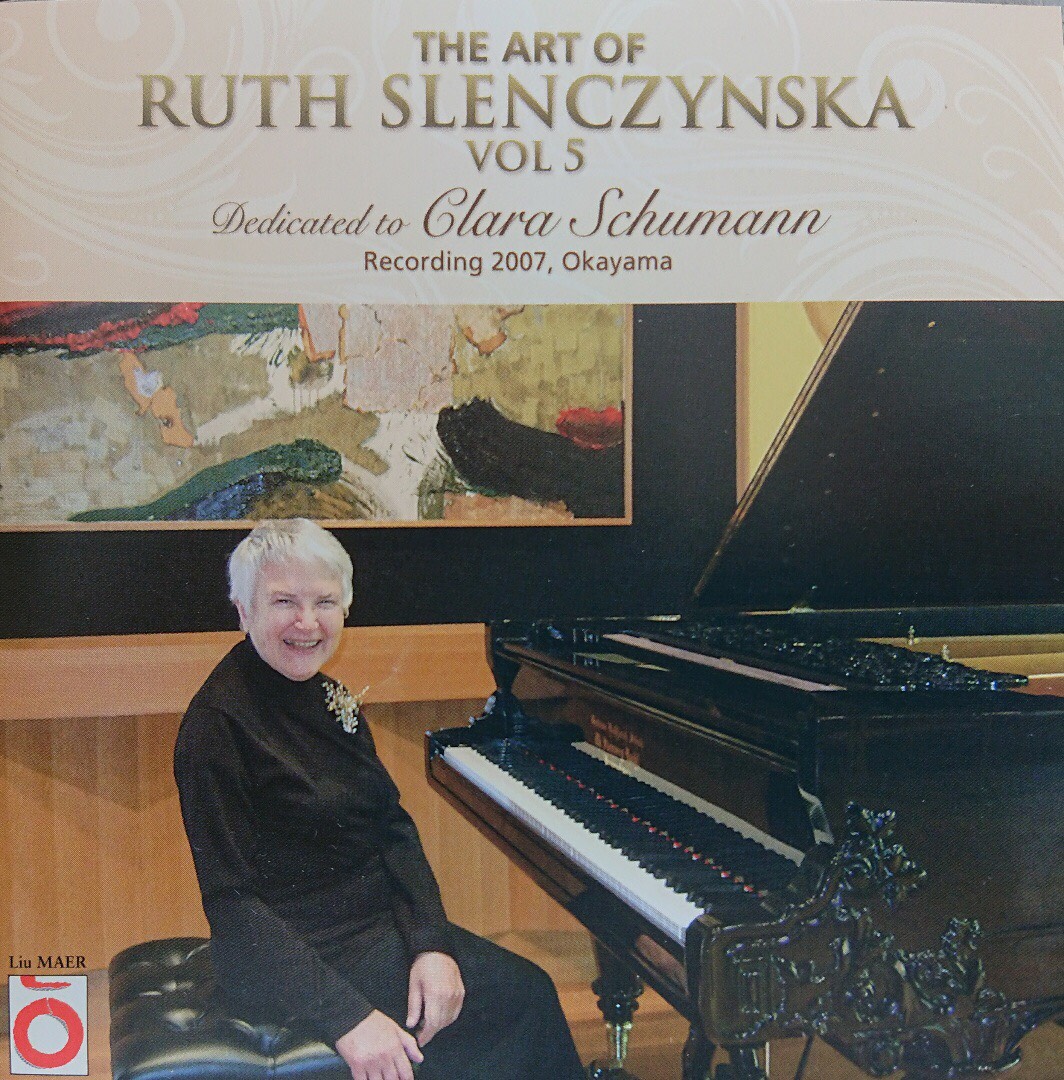Dedicated to Clara Schumann ~an encounter across time and space~
Summer, 2008 Bunsho Mifune
This CD was originally supposed to be one of the 2-CD set of “The Art of Ruth Slenczynska V.” However, due to some reasons (see the following article for further details), the other CD with Brahms’ works will be combined into the following 2-CD set of “The Art of Ruth Slenczynska VI.” Thus this time there is only one CD contained, making this release somehow unique in this series.
In April 2003, Slenczynska, aged 78, gave her first piano recital in Japan, but there was no recording left for that brilliant live performance. The repentance inside my heart became the impetus to invite her to Japan again, and she came to Japan in November 2003, July 2004 and January 2005 (which was also her last recital celebrating her 80th birthday). These performances were recorded in “The Art of Slenczynska I~IV,” containing a total of 8 CDs.
I believed and was satisfied with the fact that these recordings had left significant footprints in the history of piano performance. However, there still remained a wish in my heart, which is to invite Slenczynska, who still kept on improving her skills after stopping public performance, to record Brahms’ waltz and later piano works.
As I wrote in the following article, a miracle happened in 2006: Clara Schumann’s piano――a Grotrian Steinweg made in 1877――came into my possession, and was repaired as close to the original state as possible. This led to the incredible result that I was able to invite Slentzynska to play Brahms, Robert and Clara Schumann’s works with this piano of Clara Schumann, who had strong links with the other two composers.
When I listened to Slenczynska’s performance, I noticed one thing: whatever piano she played, she could draw out the best out of the instrument and made the audience believe in every note she played. This was not only because she had made her debut since she was three years old and given more than 3,000 recitals before the age of forty-five, playing as many pianos as one could imagine, but also because she had kept practicing 8 hours a day even after withdrawing from commercial performance at her forties and kept improving every note she plays.
Apart from the marital life, Slenczynska’s childhood, her feud with her father, the glory and shadow of being a child prodigy and the successful career as a teacher…etc, made her life even more dramatic than Clara Schumann’s. However, the two great female pianists actually have a lot in common.
The most important of all is that, although as virtuoso pianists they surpassed even male pianists, the two of them both took the highest respect towards the composers’ original ideas and despised the vain show-off of techniques, trying to find the deepest thoughts in every note they play.
Of course, Clara Schumann didn’t leave any recording of her playing, so we can only speculate from the related literature, but in my assumption, Slenczynska’s capacity as a pianist is probably higher than Schumann’s.
One reason is that Slenczynska has the knowledge of the instrumental evolution of piano as well as the 20th century composers whom Clara Schumann would never have known, so she knows better about the mechanism of piano and its potentiality. The second reason is that Clara Schumann lost her husband early in her life and had to raise 7 children (later plus 6 grandchildren!) on her own, while Slenczynska met her ideal partner at forty-three and has no child, so she could dedicate herself entirely to music. Finally, while Clara Schumann suffered from illness (and after being troubled by rheumatism at her fifties, she could hardly give any satisfactory performance), Slenczynska is blessed with good health even at the age of eighty-three now (apart from having cataract) and she has never had any problem with her fingers, so that she can practice 8 hours a day almost every day throughout the past eighty years.
In this CD dedicated to Clara Schumann, Slenczynska chose the works by Brahms and Robert Schumann, as well as Clara Schumann’s rarely performed “Larghetto,” Weber’s “Rondo,” which Clara Schumann often played, and Schumann’s “Widmung” arranged by Liszt. This program was quite probable yet never imagined before by any pianists―including Slenczynska herself―without the existence of Clara Schumann’s piano. It was as if this piano had drawn Brahms, Clara and Robert Schumann’s souls together to bring out this program.
By accident, these works were all written in the happiest periods of lives of the three musicians, who had been tied together with the threads of Fate and led troublesome lives―as if to console Clara Schumann’s soul.
However, in my opinion, the importance of this recording not only lies in the fact that the piano was repaired to nearly the same state as Clara Schumann played it 130 years ago and got the best player to enhance the significance of these works, but also in the fact that Slenczynska has created a new interpretation of Brahms’ work that even Brahms himself would never have imagined (as she did to all the other composers) and left this remarkable album for us.
translator Kiyoko Kruzliak

The Art of Ruth Slenczynska V
クララ・シューマンのピアノを弾く!
- Recording
- Nov.12th and 15th, 2007 Liu Mifune Art Ensemble
- Piano
- Grotrian Steinweg (1877, No.3306) in Lie Mifune Art Ensemble
- Performance
- Ruth Slenczynska (Piano)
2007年、数奇な運命を経て、日本で新しい命を与えられたクララ・シューマン愛用のグロトリアン・スタインヴェッグ(No.3306 1877年製)からルース・スレンチェンスカが呼び寄せたクララ、ロベルト・シューマンとヨハネス・ブラームスの魂の声がここに。2005年の驚異のラスト・コンサートから2年、82歳の幻の巨匠ルース・スレンチェンスカが極めたピアニズムの豊饒な楽園。
 〒703-8266 岡山県岡山市中区湊836-3
〒703-8266 岡山県岡山市中区湊836-3

